The world was in a much different place when Wade Wilson, aka Deadpool, made his comic book debut in The New Mutants in 1990. The first of two Bushes was President, Nirvana had yet to release Nevermind, and the only superheroes who had movies were Superman and Batman. It took many years and a whole lot of writers and artists, but eventually, Deadpool rose the ranks to become a genuine superstar in the vast canon that is the Marvel Universe.
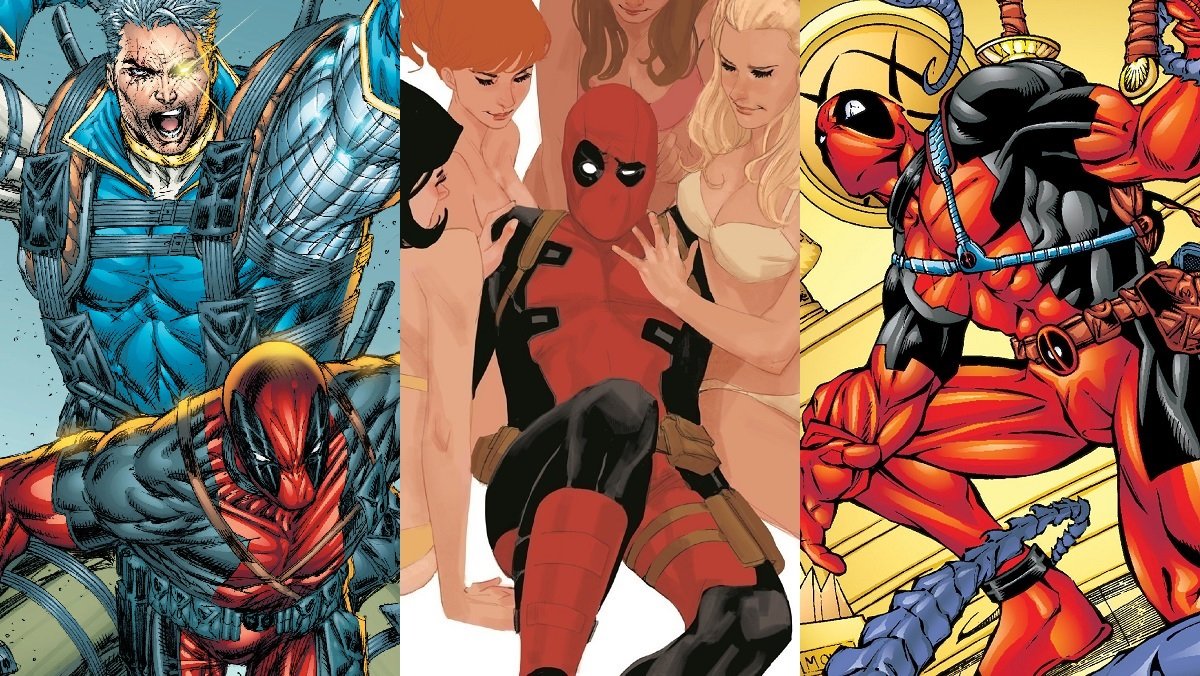
Today, you can’t walk around the mall (if there’s still one open near you) and not see Deadpool somewhere. The Merc with the Mouth is a serious pop culture icon, his red and black mask plastered onto t-shirts, hoodies, Funko figures, and so much more. With not one, not two, but three theatrical movies under his belt, one could argue Deadpool is as big as Mickey Mouse.
In the world of comic books, dozens of brilliant comics writers have shaped Deadpool into the wisecracking, chimichanga-munching anti-hero we know him to be. While Ryan Reynolds tears up the screen yet again as Deadpool in the new Deadpool & Wolverine, it’s high time to look back at some of the all-time greatest Deadpool comic runs. Whether you’re a completionist looking to curate the perfect library or a newbie still dipping a toe into comics, or someone in between, this list is for you if you need a little Deadpool in your life. (Don’t we all?)
9. Deadpool by Mark Waid
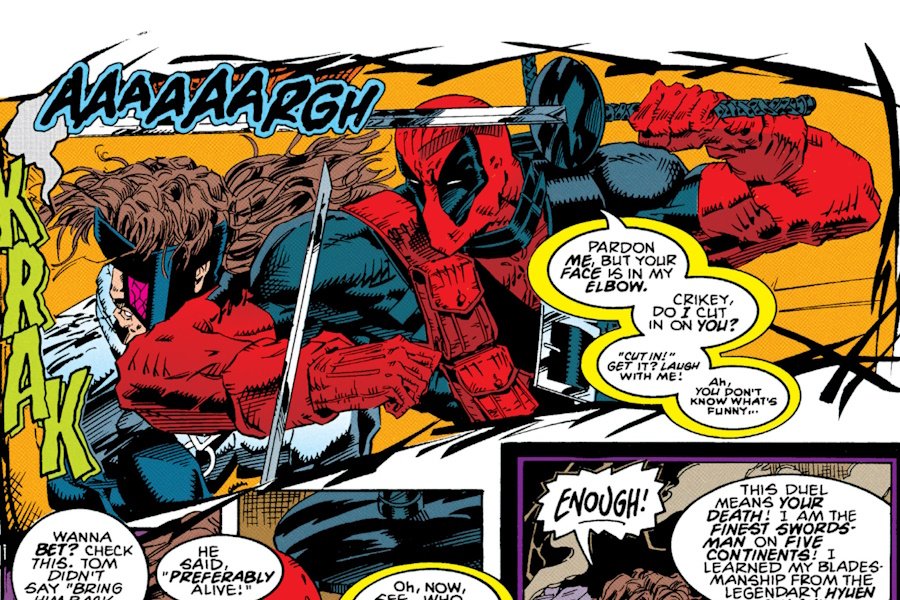
Deadpool’s metamorphosis into the wisecracking, fourth wall-breaking mercenary we know him now was a slower evolution than you might think. Revisit his debut in The New Mutants and early X-Force appearances and you’ll find a different Wade Wilson than you know today. This isn’t to say Deadpool wasn’t a blabbermouth back then, but his personality hardly stood out from the other hard-edged mutants he was pitted against. After the mild success of his first solo mini, Deadpool: The Circle Chase by Fabian Nicieza and Joe Madureira, there came a second miniseries that has flown under the radar since its 1994 publication, simply titled Deadpool by writer Mark Waid (with art by Ian Churchill, Jason Temujin Minor, and Bud LaRosa).
While it lasts just four issues, Waid – who was in the midst of a hot streak at the time, with titles like The Flash and later Kingdom Come at DC – strikes a fine balance between dark, edgy machismo with Deadpool’s developing humor. The story isn’t much to write home about; Deadpool’s favorite bar gets wrecked, and so the Merc teams with mutants like Siryn and Banshee for payback all while his healing factor malfunctions. But the visual art is peak ’90s maximalism, combined with a dash of Waid’s belief that Deadpool will get what’s coming to him – or so Waid thought. In a 1997 interview with Wizard, Waid later expressed regret writing the series, saying: “Someone who hasn’t paid for their crimes presents a problem for me.”
8. Hawkeye vs. Deadpool by Gerry Duggan
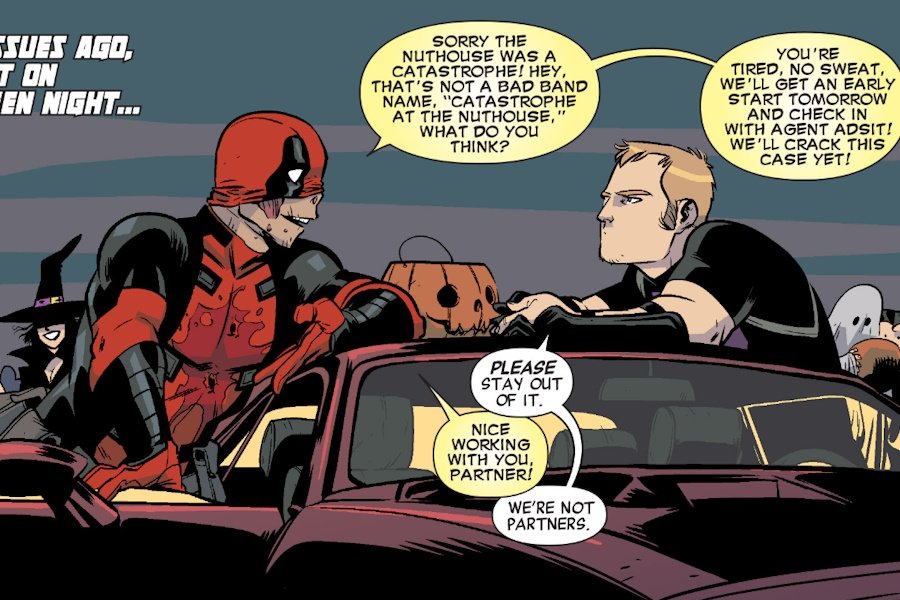
You’ll pardon the awkward numbering of the five-issue miniseries Hawkeye vs. Deadpool, which begins with issue #0 and ends with issue #4. But this delightful action-comedy romp splatters the walls with hilarious bits that really put the “comic” in comic books. Beginning on Halloween night, Deadpool runs into Hawkeye, with the two quickly teaming up to investigate a murder mystery involving a dead body and a strange USB drive. (It makes a curious case of the word “vs.” in the title, to be frank.)
Continuity-wise, the miniseries intersects with Gerry Duggan and Brian Posehn’s monthly Deadpool (including a gut-busting cameo from the ghost of Ben Franklin, originating from the first story arc). It also in a lot of ways acts as a spiritual continuation of Matt Fraction’s acclaimed Hawkeye. But Hawkeye vs. Deadpool is so fast-paced and such a fun read that you don’t need to read anything else even if you’re a dedicated completionist. If you need to kill a single afternoon and want to split your sides, Hawkeye vs. Deadpool is a real bullseye.
7. Black Panther vs. Deadpool by Daniel Kibbelsmith
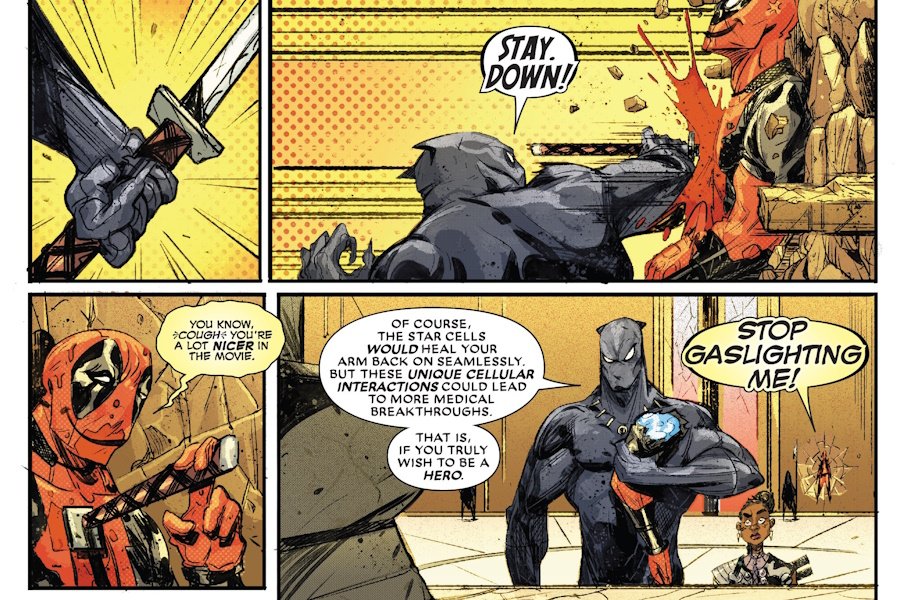
When Marvel’s Black Panther grossed billions at the box office in 2018, everything about him exuded untouchable royalty. But only a transgressive, innocently offensive character like Deadpool could dare scratch the king of Wakanda. From writer Daniel Kibbelsmith, the five-issue crossover miniseries Black Panther vs. Deadpool wholly banks on the oddball novelty of its marquee characters duking it out.
After Deadpool’s efforts to save Brooklyn from a Z-list villain results in collateral damage, Deadpool embarks on an urgent mission to Wakanda to retrieve precious Vibranium in order to save a life. While Deadpool politely asks T’Challa at first, the noble Black Panther rebuffs him, leading the two to put claws to katanas. With former Late Show with Stephen Colbert writer Kibbelsmith at the helm, Black Panther vs. Deadpool is a propulsive read. It’s a breezy collision of action and comedy in a showdown no Marvel fan knew they wanted until now. The visual art matches the manic energy of the miniseries, with both Deadpool and Black Panther looking especially feral in jagged and slanted lines.
6. Deadpool by Joe Kelly
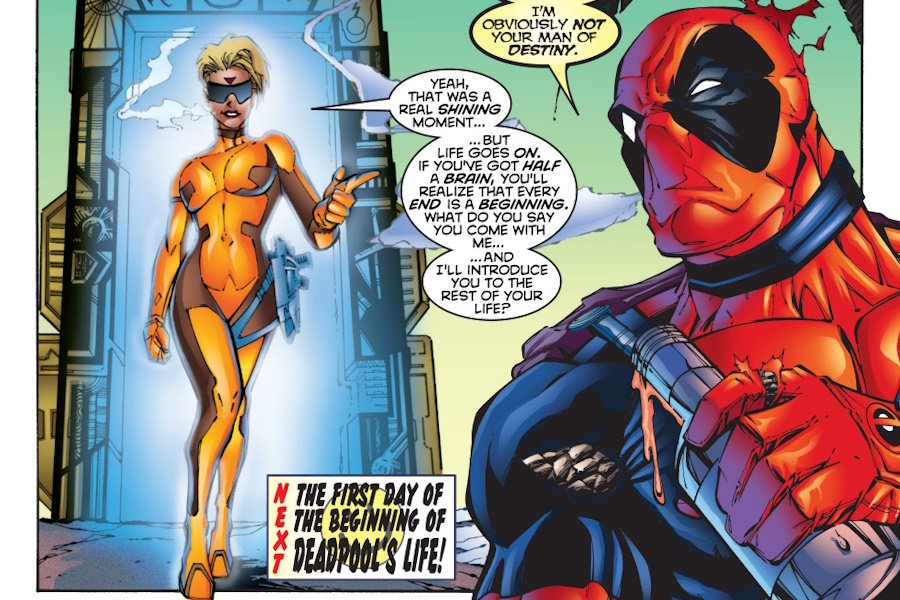
If you want the origins of Deadpool, the character, read The New Mutants. If you want the origins of Deadpool, the satirical and determined jester in red spandex who takes on life one katana swing at a time, read Deadpool by Joe Kelly.
After establishing himself at Marvel on works like Fantastic Four 2099, Joe Kelly embarked on his first monthly assignment: a new Deadpool series in 1997. This very lengthy run gave us most of the hallmarks fans associate Deadpool with today: the breaking of the fourth wall, the abundant pop culture references, even Deadpool’s annoyance factor that gives everyone else in the Marvel Universe a headache. (Wanna see Deadpool reference Street Fighter and uppercut Kitty Pryde while screaming “Shoryuken”? That’s issue #27.)
But past all the juvenile humor is the pathos of a lonely soul who bounces around like an unwanted pinball. Rob Liefeld and Fabian Nicieza shaped Deadpool out of clay, but it was Joe Kelly who gave him a lasting presence. After Kelly’s run on the ’97 Deadpool ended with issue #33, with the series taken over by Christopher Priest (whose run is less acclaimed but no less interesting) and then a series of other freelance scribes before Gail Simone took the series home to – and Deadpool would giggle at this – issue #69.
Issues in Joe Kelly’s run: Deadpool #-1 (flashback one-shot published after issue #6), Deadpool #0, Deadpool #1-33, Annual Deadpool & Daredevil ’97, Annual Deadpool & Death ’98
5. Uncanny X-Force by Rick Remender

Deadpool has never been much of a team player. But that all changed in Rick Remender’s Uncanny X-Force, a continuation of the 2008 X-Force by Craig Kyle and Christopher Yost. Remender’s story picks up after Cyclops shuts down X-Force, with Wolverine covertly keeping operations running as X-Force leader. This new iteration of X-Force consists of Psylocke, Fantomex, Archangel, and Deadpool, who all adopt an incredibly sick black and white uniform color scheme. (Honestly, more superhero teams should adopt unified colors like pro sports.)
Deadpool maintains his rep as a jokester, but Uncanny X-Force turns down the volume on his obnoxiousness to suit the series’ overall serious tone. This doesn’t mean Deadpool takes it easy on Apocalypse, mind you. But Uncanny X-Force isn’t Deadpool’s show to steal, as the Merc lets his pal Wolverine and the more enigmatic Fantomex take up more attention as the series’ main protagonists. Between its gorgeous art and strong character-oriented writing, Uncanny X-Force is not just a great Deadpool title but a great X-Men-adjacent title overall.
4. Deadpool: Bad Blood by Rob Liefeld
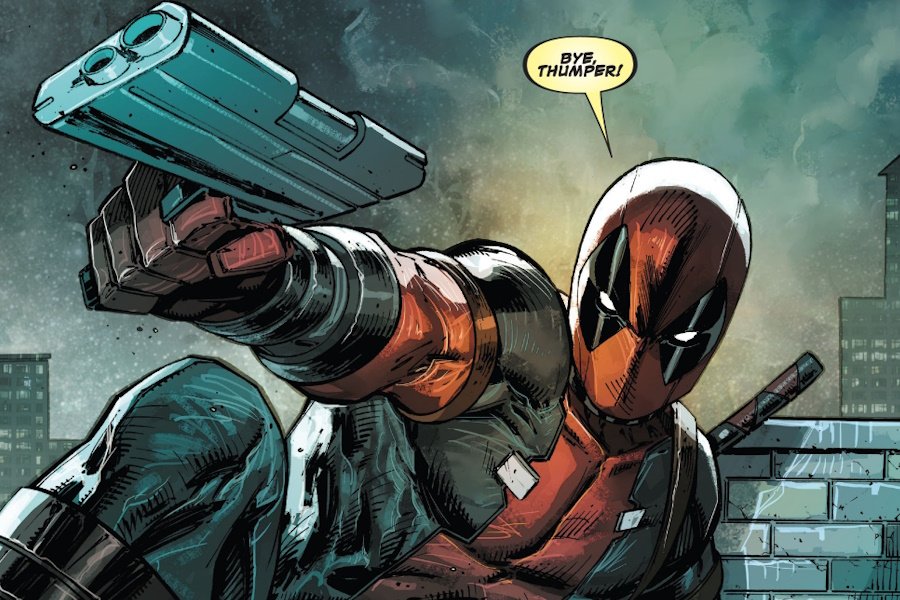
Say what you want about Rob Liefeld. When you read a Deadpool comic written by Liefeld, it’s like watching a Terminator flick directed by James Cameron: Nothing beats a proven creator working on their most famous creation.
In 2017, the popular if also divisive comics legend got the greenlight for Deadpool: Bad Blood, an entire Deadpool graphic novel. (Along for the ride are writers Chris Sims, Chad Bowers, and artists Romulo Fajaroo Jr. and Joe Sabino.) The contained series introduces a new nemesis for Deadpool, a thick brawler named Thumper whose past connections to Wade Wilson run deeper than most others in the Marvel Universe. Conceptually a celebration of Deadpool’s early history as seen through Liefeld – including a “reunion” of the original X-Force, albeit in flashback – Deadpool: Bad Blood has all the hallmarks of ’90s era Deadpool with modern touches. The awkward bodily anatomies and aggro aesthetic ain’t a bug baby. They’re all features.
3. Spider-Man/Deadpool
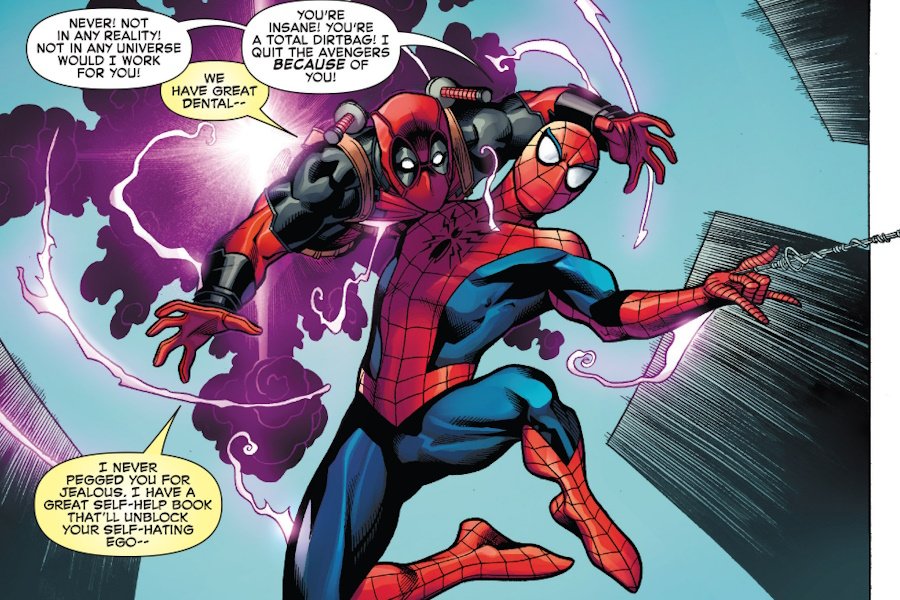
2016 was a great year for Spider-Man and Deadpool. That year, Ryan Reynolds starred in the box office smash Deadpool, an R-rated party at the theater that fans waited for literal years to happen. Shortly after that, Tom Holland swung into his Marvel Cinematic Universe debut as Spider-Man in Captain America: Civil War. So it was excellent timing when Marvel published that same year Spider-Man/Deadpool #1, the first of an epic 50-issue series in which the friendly neighborhood wall-crawler puts up with the decidedly unfriendly assassin.
But while Spider-Man/Deadpool could have rested on its laurels with its A-list characters, the series’ revolving door of top tier writers were not content with mediocrity. Starting with veteran Deadpool writer Joe Kelly, Spider-Man/Deadpool relishes in the unabashed fun of a mismatched pair like Spidey and DP before further exploring what these characters mean to each other. For Spider-Man, he learns to see the person behind the violence and the humor; for Deadpool, he aspires to hold himself to a higher standard of costumed crime fighter. (Also: The series coincides with Peter Parker’s role of CEO of Parker Industries, so Deadpool’s interference of Spidey’s daily routine often gets extra funny.)
Whether it’s roasting Batman v Superman: Dawn of Justice (issue #6), running into Penn & Teller (issue #11), or speculating their elderly future in the multi-part arc “Oldies,” Spider-Man/Deadpool makes the absolute most of their unstoppable leads. In addition to Kelly, the series also sees writers like Scott Aukerman, Gerry Duggan, Paul Scheer, and Robbie Thompson take a swing at writing the delirious duo.
2. Cable & Deadpool by Fabian Nicieza
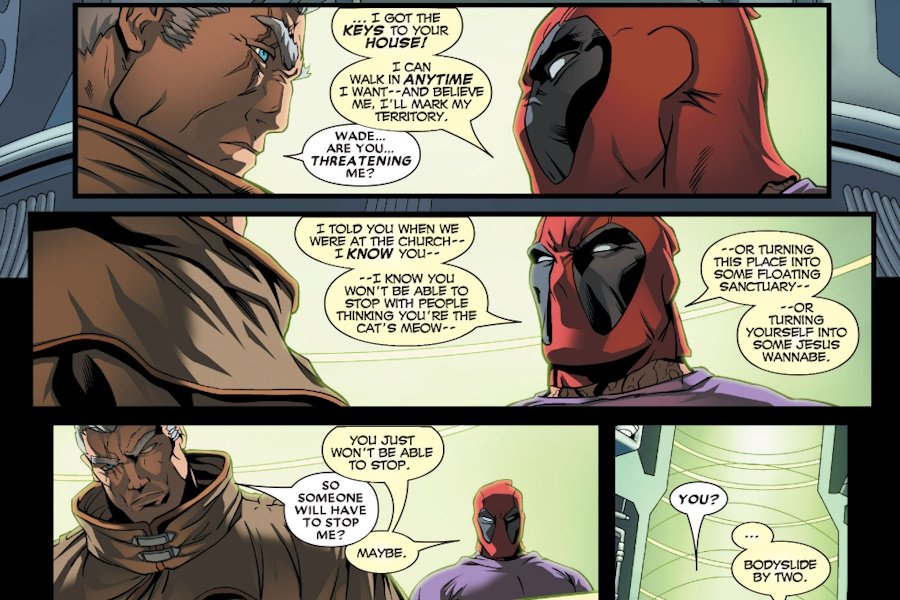
Sometimes, sequels really are better than the originals. After both Deadpool and Cable’s solo titles were canceled, these two gun-toting mutants joined forces to star in Cable & Deadpool, easily one of the best mainstream superhero comics of the 2000s. Written by Fabian Nicieza (with artist Reilly Brown scripting the final two issues), Cable & Deadpool is quintessential 2000s superhero bombast with the distinct vibe of a classic buddy action movie.
The story starts with Cable determined to use his powers to change the world for the better only to wind up before Deadpool, who is hired by a cult to steal a virus that will uniformly turn everyone’s skin color on Earth blue. Eventually, Cable and Deadpool obtain the power of teleportation, with the utterly ingenious caveat being that whenever it’s used, they both teleport. From there, Cable and Deadpool become an unlikely but dynamic pair – plus a later addition in Bob, Agent of Hydra – who come face to face with everyone in the Marvel Universe, from the Fantastic Four to the Avengers to the then-married power couple of Black Panther and Storm.
Cable & Deadpool sports an array of different artists, all of whom bring to the table their own individual styles. That said, there is a pretty criminal overuse in digital airbrushing, as well as an overall aesthetic you could describe as “American manga” (a strange phenomenon unique to the mid-aughts, when anime was still in the midst of discovery by the American mainstream). But no matter how it looks, Cable & Deadpool is a delight from page to page, and proof that the end of one thing is always the start of something new.
1. Deadpool by Gerry Duggan and Brian Posehn
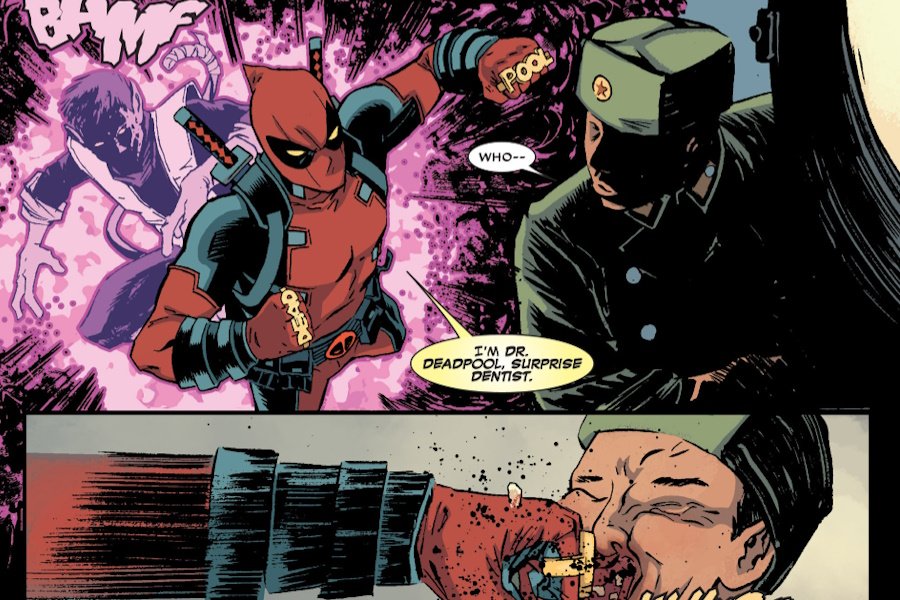
As the dust settled on Avengers vs. X-Men, Marvel kicked off a new publishing initiative dubbed Marvel NOW. Among its biggest titles was a brand new monthly Deadpool series, co-written by veteran scribe Gerry Duggan and comedian Brian Posehn.
Once again bearing the simple title of Deadpool, the series restored a lot of lost glory for the Merc with the Mouth, following Deadpool figuring his place in the wider Marvel Universe and enduring shocking revelations along the way. Minor spoilers, but at one point Deadpool meets his biological daughter, an adorable li’l mutant named Ellie Camacho.
The starting arc of Duggan/Posehn’s Deadpool is a doozy, in which an amateur sorcerer brings back the souls of dead U.S. presidents in hopes of – ahem, making America great again. (This came out in 2013, by the way.) While that first arc is divisive, the rest of the series is peak Deadpool, a masterful balance of DP’s antics and outrageous challenges with profound emotional angst. Across 45 issues, Duggan and Posehn’s Deadpool is the platonic ideal for anyone looking for a good time that goes for a long time.